
October is Breast Cancer Awareness Month
Every October the world unites in a sea of pink to observe Breast Cancer Awareness Month. Sadly, I think we all know someone who has been touched by breast cancer.
It’s not only women who get breast cancer. In 2017, 389 men in the UK were diagnosed with the disease, and 30 with carcinoma in situ, a type of none-malignant breast tumour. (Source, Breast Cancer UK website, 2023)
October’s theme for Breast Cancer Awareness month is ‘Get Active!’ Get active to raise money. Get active to reduce your risk of breast cancer. Studies show that by increasing your physical activity, you can significantly reduce your risk by as much as 20% – So get active, reduce your risk, and have fun raising money!
Our top tips to reduce your risk
- Maintain a healthy wait for your height
- Move more – being active can significantly reduce your risk
- Eat less processed meat and other processed foods
- Eat plenty of fruit and vegetables
- Drink less – no more than 14 units (equal to 6 pints of beer) a week
- Choose cleaning and grooming products that don’t contain known EDC’s
Alcohol, diet and weight
Alcohol
Most of us know that drinking to excess can have serious implications on our health but how many of us know that alcohol consumption increases our risk of breast cancer? Just because you drink alcohol doesn’t mean you will automatically get breast cancer. It does however mean that your risks of developing it will be increased. The more alcohol you drink, the higher the chance of developing the disease.
Drinking less alcohol will lower your risk of getting breast cancer, but even women who never drink alcohol are still at risk. There are also many other risk factors that impact our chances of getting breast cancer, some of which (like our age) are beyond our control.
Diet
Any healthy diet should include a varied selection of foods, that are as natural as possible, and provide the right amount of energy and nutrients. By making better food choices you can reduce your risk of developing breast cancer.
Foods may contain compounds that are protective against breast cancer and others that may have a cancer-promoting effect. So, what you eat and what you don’t is important. There is no ideal diet for breast cancer prevention. It is more important to pay attention to the proportions of individual foods.
Many diets can be healthy and help reduce risk, including, the Mediterranean diet, as well as vegan and vegetarian diets. They all combine certain basic features, e.g. no or low red meat consumption and a high proportion of fruit and vegetables.
Key Facts – What’s good?
- A diet high in fruit and vegetables (especially non-starchy vegetables and foods high in carotenoids)
- Ensuring sufficient dietary calcium from dairy or non-dairy sources (e.g., soy), limiting processed meats (e.g., bacon) and red meat
- Maintaining a healthy body weight, especially if you are middle-aged or older
- An example of a healthy diet that can help reduce the risks of breast cancer is the Mediterranean diet
Maintaining a healthy weight
Maintaining the correct weight for your height is a key part of ensuring you reduce your risks of breast cancer. There are many reasons why you might put on weight, inherited genes, lifestyle and of course, what you eat can play a huge part.
Keeping a healthy weight can sometimes be easier said than done but the key thing here is to only eat as much as you need – so you don’t gain excess weight.
Variety and portion control
Managing what you eat is just as important as how much you eat!
Your age, sex, height, and activity levels all play a part in determining what portion size you should be eating. Judging what size of the portion you should eat is key, and your own hand can serve as a simple measuring aid.
Fruit and vegetables
- 5 or more portions per day (at least three portions of vegetables, two portions of fruit)
- One portion of fruit can be classed as one whole fruit, such as an apple, a banana, a pear, or an orange.
- One portion of vegetables can be classed as two large broccoli spears (or eight small florets), or four heaped serving spoons of cooked kale, spinach, spring greens, or green beans.
Starchy carbohydrates
- 3-4 portions per day
- One portion (lighter meals) can be classed as six small cooked new potatoes, about one and a half handfuls of porridge (dry weight); two slices of medium-sliced wholemeal bread.
- One portion (main meals) can be classed as two handfuls of plain, dried wholemeal pasta; two handfuls of wholemeal, dried rice; one large wholemeal bread roll.
Protein (beans, pulses, fish, eggs, meat, and others)
- 2-3 portions per day
- One portion (lighter meals) can be classed as two eggs, or 80g of tofu, or about six tablespoons of lentils, beans, or other pulses.
- One portion (main meal) can be classed as about half the size of your hand of raw salmon fillet or raw mackerel fillet.
Dairy and alternatives
- 2-3 portions per day
- One portion can be classed as one glass of milk (semi-skimmed) or unsweetened plant-based milk, or about 4 tablespoons of plain yoghurt (low fat), or about 3 tablespoons of cottage cheese.
Tip – the hand should only serve as a general portion guide. You may need bigger or smaller portions depending on how tall or active you are.
To find out more about breast cancer support please visit Breast Cancer Now UK